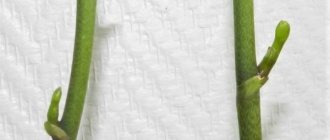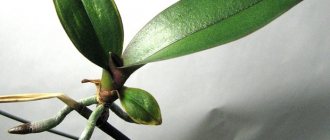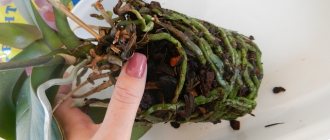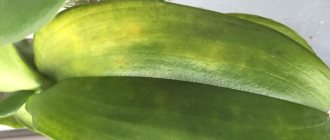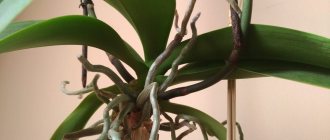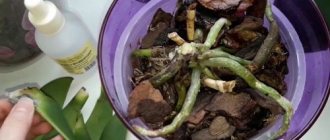Pruning the peduncle
It is necessary to organize proper flower care before, during and after the completion of the flowering process. At the stage after flowering, pay special attention to trimming the peduncle. In some situations it is not just desirable, but necessary:
- if a young green branch suddenly changes color - it turns yellow, turns red, or acquires a brownish tint;
- completely got rid of the petals;
- dried up along with the petals.
Note.
This should not be done unless there is a serious need and indication for pruning. Unnecessary manipulations with the plant will only cause harm: they will stop flowering, accelerate wilting and prevent the development of children.
Preparation for pruning involves collecting tools - a sterilized pruner and sharp scissors, and organizing a work space.
If the plant exhibits one of the three criteria for pruning, the orchid peduncle should be trimmed immediately. First, it is recommended to carefully examine the plant:
- how much it dried out;
- the peduncle did not break off;
- what condition are the leaves in?
After inspection, you need to find a newly formed bud that is ready to bloom. By eye, step back approximately three centimeters from the formed bud and trim with pruners or scissors. If the resulting dry place has dried out the flower arrow, it is unlikely that anything can be done to save the plant. Cut off the completely dry peduncle with pruning shears at the very base. After trimming, treat the damaged area with regular brilliant green.
An orchid has a broken peduncle: what to do
If the peduncle of an orchid breaks, the situation is quite unpleasant, but not critical. It will not lead to the death of the plant. With proper care, a new arrow may appear. When breaking off a peduncle, it is better not to touch anything, but to leave everything as is. To prevent breaks, you need to fasten the peduncle - it prevents the arrow from breaking and corrects its growth in the right direction.
Selecting a plant and trimming the peduncle
First, before purchasing, you need to inspect the roots of the tropical plant. If they are white-green or bright green, then the plant is absolutely healthy. If the roots are green, the plant does not need to be watered, it feels good. If the roots turn white, the flower needs watering. Inspecting the roots will not be difficult, because phalaenopsis is sold in many flower shops.
What to do if the orchid's peduncle breaks? The site of the broken sprout should be carefully inspected. If there are buds on the surviving part of the stem below the broken area, then there is no reason to be upset. It often happens that the kidney wakes up again and shoots a new arrow. After all, the plant is already in the mood to bloom. The blooming of an orchid may not be abundant, but it is pleasant for its breeder.
A broken stem should not be left, especially if there are no buds on it. Soon the stem will dry out. It is recommended to cut off the shoot at the base.
This must be done carefully, without damaging the roots and leaves. A broken peduncle does not harm the flower. There are some positive aspects to this.
Breaking off the stem will stimulate the growth of stronger shoots and restore strength after flowering.
Why does a flower arrow break off and how to prevent it
When growing orchids, inexperienced gardeners make a number of mistakes when caring for the plant. When a peduncle appears, it is necessary to provide support for the plant.
Often the arrow appears at the base of the flower from the lower leaves. If the garter is not done in a timely manner, the stem may begin to grow to the side or down.
When the buds begin to bloom, the shoot may break under their weight.
The support should be installed in the pot as soon as the stem begins to appear. As the peduncle grows, it is attached to the support with a clothespin or hook. They form an escape without causing harm. There are also several factors that lead to flower damage:
- Wrong place for phalaenopsis. Uncomfortable presence with neighboring flowers, lack of lighting and moisture
- Presence of pets. They may drop or break the flower. To avoid trouble, the orchid should be placed in a place inaccessible to animals.
What types of damage occur and how to revive a flower?
A broken shoot is not a reason for frustration. Phalaenopsis can be saved. First you need to assess the current situation. What to do if the peduncle of an orchid breaks off:
- Partial stem break. If this happens and some of the buds remain, then the remaining buds will be able to open.
- The peduncle has completely come off, but there is 1 bud at the base. Often a stem grows from it. It will be thinner than usual and with few colors.
- The flower shoot withered after being damaged. The plant needs to be resuscitated. The normal temperature, light level and standard watering should be maintained.
If the orchid still has several small roots, you can try to save them. This can be done using a greenhouse. You will need an aquarium and a 10 liter plastic bottle. The greenhouse should be located in a warm place without direct sunlight. You need to pour expanded clay into the container, add sphagnum moss and plant the roots.
A glass of water is placed in the aquarium to create the required level of humidity. Within a few days, new roots will appear on the plant.
Flower roots can be grown in water. Place the culture in a jar of water so that the roots do not touch the bottom. Immerse the roots in water daily and drain it after a few hours. Repeat this for several days in a row.
If the peduncle breaks off, you can carry out activities in the substrate. It should consist of:
- tree bark;
- expanded clay;
- tightly compacted sphagnum moss.
Immerse the plant in the substrate. Roots should appear in six months.
There is another way. Fix the phalaenopsis on the bark and treat it with a special compound containing vitamin B1. Do not water the orchid at this time. After 3-4 months, new roots appear, which should not break off.
What to do after damage to the peduncle
If the arrow is not completely broken and the orchid does not bloom, treat the broken area with antimicrobial agents to avoid infection:
- Grind activated carbon into powder and apply a thin layer of powder;
- Grind charcoal into powder and powder;
- cinnamon - grind and powder in a thin layer.
If the remaining part is more than half of the shoot, then there is a possibility that the bud may bloom. If the layer is above the lower bud at the ground point, it must be treated as if the stem was broken.
Then you need to observe the plant for some time:
- Without additional effort, the shoot will grow on its own.
- If the bud freezes, then the orchid needs help; for this, use growth stimulants (cytokinin paste has proven itself especially well). Treat the needle with alcohol, use it to bend the scales, apply a little paste in a thin layer. You must be careful not to break the flower. When 2 shoots appear, one must be removed using the sharp end of a knife. Treat the cut with activated carbon.
When the stem dries completely, there is a possibility that this process will spread to other leaves. If a large shoot has affected the rosette, then it needs to be cut off as much as possible. The cut area must be treated with alcohol and dried. Apply an antibiotic to the wound. In this case, the plant must be protected from infections.
To develop the root system, growth promoting drugs should be used. The most effective are:
- Radifarm.
- Etamon.
- Zircon.
To prepare the solution, the product should be dissolved in water and used according to the attached instructions.
Green root and stem death
Orchid can be found in many modern apartments. Many phalaenopsis lovers do not know the basic points of caring for the plant. Orchids sold in stores are hybrids bred for indoor living. In cases where a flower falls off a peduncle or the leaves turn yellow and fall off, the processes of photosynthesis and moisture evaporation do not occur, then it is necessary to help the plant.
https://www.youtube.com/watch?v=zjjO_j260RU
If the root tip is healthy, then the phalaenopsis is able to accept nutrients for revival. A young plant with weak roots is more likely to die than an adult plant.
If the stem dies, the main attention should be paid to the root system. It is necessary to conduct a detailed study of it.
You may be interested in:
If the root system has green buds, you can try to restore it. You need to feed your pet with fertilizer containing nitrogen and adding a growth stimulant. If the plant is susceptible to treatment, then within a few months the flower will begin to grow and may begin to bloom.
When using drugs to enhance growth, phalaenopsis will produce new roots. To grow new shoots and roots, it is good to use stimulating complexes:
- Zircon;
- Fitosporin;
- Kornevin;
- B vitamins;
- Etamon.
To improve flowering, leaves should be treated with dissolved succinic acid. It improves immunity, activates the growth of the root system and promotes the growth of green young shoots.
An orchid is a demanding and capricious flower. For its proper development and growth, it is necessary to comply with growing conditions, maintain optimal temperature, light and humidity. It is necessary to regularly feed and protect from various damages.
When a peduncle appears, be sure to use a stem support. When adding up all the growing rules, the plant’s roots will be strong and the flowering will be long. Beautiful tropical flowers will serve as a reward for a caring owner.
Source: https://sveklon.ru/chto-delat-kogda-u-orhidei-lomaetsya-tsvetonos
Why flower arrows break and how to prevent it
If an orchid has a broken peduncle, what to do with the broken area is not always clear. If the area is not treated properly, it is likely that the plant will no longer bloom. The reasons for the breakdown are different:
- It is easy to break due to mechanical stress - during transportation, careless care, damage during pruning.
- The flower lacks vitamins. If a branch breaks just like that, you should pay attention to the thickness: if it is too thin, you should think about additional nutrition for the flower - change the fertilizer, use a new formula or procedure.
- A new orchid, the peduncle has broken, what to do - most likely the flower was damaged during transportation or timely care was not provided during the overexposure.
There are several types of damage. Some of them prevent the further development of the flower, while with others it is able to continue to grow normally.
- Partial break of the flower. Let's say the stem breaks in the middle, and there are still unopened buds at the bottom. Not the most dangerous damage. No steps should be taken other than treating the broken area with green paint; the flower will repair itself.
- The peduncle broke at the very base, on which a bud had already appeared. It is this bud that will create a new stem, but it will not be as strong.
- Careless damage caused drying out. The most difficult situation requiring resuscitation measures in the form of temperature and watering conditions, lighting and fertilizer.
Attention.
First of all, you need to restore the root system of the flower, since it is responsible for nutrition. This is done through fertilization, regular watering and other measures.
Reanimation of the root system
Depending on the existing conditions and the severity of the damage, you need to choose one of the recovery methods:
- Greenhouse. Rinse all the roots and place the flower in a container specially created for this purpose with a good ventilation and moisture system. Create a homemade greenhouse on top - wrap cling film or a transparent plastic bag around several sticks. In the greenhouse the temperature should not fall below 23 degrees. With regular watering three times a week and fertilizing once a week, the flower will recover in less than a month.
- In water. Place the well-washed root system in water for several days. Change the liquid once a day. After the flower’s condition improves, immediately remove it from the water to avoid rotting.
- In the substrate. Clean the root system, sprinkle damage on the roots with cinnamon. Prepare the substrate in advance. Without damaging the root system, carefully transfer the plant to the substrate, cover it and water well. Do not fertilize.
- On the bark. Pour a mixture of dried bark from several trees into a small amount of soil, mix, place the flower on top and sprinkle again.
Use growth stimulants to restore a damaged flower:
- Auxins, cytokinins. Strengthen cell division, ensuring growth.
- Brassinosteroids. Stimulates the emergence of seedlings.
- Vitamins. Provide circulation of nutrients along the entire length of the plant.
- Amino acids. Prevents exposure to various diseases.
Green root and stem death
Green roots indicate several controversial activities:
- The plant is doing well, it has just begun to develop.
- This is moss caused by over-watering. In this case, it is recommended to wash the root system and stop watering for a while and check the reaction of the flower. If the color of the roots has changed, reduce the amount of watering. It is better to over-moisturize an orchid than to under-moisturize it.
If the stem has dried completely, the leaves have become withered and there is not a single green bud, it is impossible to save the plant. If at least one green petal remains, the flower has a chance of survival.
Note.
To grow new roots in an orchid, the flower needs to be regularly fertilized with growth stimulants, placed in a greenhouse and watered on a strict schedule once a day. Then, for one day, place the flower from the ground directly into the water and apply these procedures three times. As soon as fresh roots appear, do not stop caring. The plant should be fertilized and watered according to a schedule within a month after growing the roots.
The breaking of a peduncle does not always mean the complete death of the plant. But it is better if caring for orchids after such a situation is organized step by step.
But what can be done to restore the plant?
As we have already found out, a partially broken and not dried stem will not harm the orchid in any way, and the plant will gradually recover on its own. If the stem breaks off at the very base or the partially broken peduncle begins to dry out, then saving the orchid will require more effort on your part.
When the stem breaks at the base
If there is only one bud left on the broken peduncle, then the tip of the damaged stem is treated with crushed activated carbon or cinnamon. This will help disinfect the plant, and after a while it will begin to recover on its own. If this process goes without problems, then after some time the remaining bud will give a new arrow.
If the bud begins to freeze, you will have to use a growth stimulator. Cytokinin paste is most suitable for orchids. It should be used as follows:
- using a needle or toothpick disinfected with alcohol, carefully bend the upper scale of the bud;
- Coat the inside of the kidney evenly with a small amount of the drug. A small drop on the tip of a needle or toothpick is enough for this;
- To stimulate growth, place the plant in a place where the difference between day and night temperatures will not exceed 2 degrees.
If everything is done correctly, then after some time a new shoot will begin to appear from the bud. More than one shoot is not required, so if there are two, one must be removed. Don't forget to treat the cut area with a disinfectant.
When the broken peduncle dries out
If the broken stem begins to dry out, there is a risk that this process will take over the rest of the flower. To avoid this, the dried part of the peduncle must be removed. You can use scissors for this, but a stationery knife is more suitable, since its thin blade makes it much easier to make a neat cut. Before removing the dried part of the stem, the knife must be treated with alcohol. Trim the stem back to living tissue. After this, wait until the juice from the wound stops oozing and treat it with an antiseptic.
If the peduncle is removed, a new one will no longer grow in this place. Nevertheless, you still need to trim the dry stem, because this is the only way to save the entire orchid. To enhance plant protection, treat it with a fungicide of biological origin, for example, Mikosan, Fitosporin or Glycadin. The listed drugs are harmless to the environment, humans and animals.
The purchased drug must be prepared strictly according to the instructions that come with each package. The solution is sprayed onto the substrate and the above-ground part of the orchid. This will protect the plant from the development of most diseases to which the flower is susceptible.
A broken peduncle will not cause serious injury to the plant. After some time, a new stem will appear, and the orchid will begin to bloom again. But if you do not want to lose the peduncle and wait for a new one to grow, do not forget to tie the stem to an additional support immediately after its formation. The support must be strong enough to support the heavy peduncle without damaging it.


